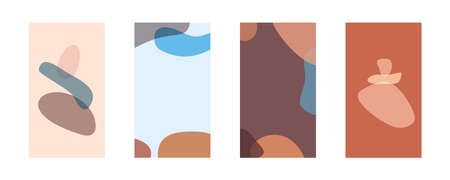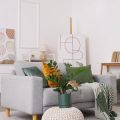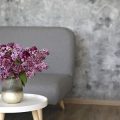Introduction: Embracing Maximalism in Compact Urban Living
Maximalism is making a remarkable comeback, especially within the snug dimensions of small UK flats. Gone are the days when limited space meant sacrificing style for function. Today’s urban dwellers are embracing a bold, expressive approach to interiors that champions personality and comfort. Layering textures and patterns has become an essential tool for transforming compact spaces into inviting sanctuaries that reflect the unique tastes of their inhabitants. This design ethos thrives on curated abundance—think tactile throws, richly patterned cushions, and artful juxtapositions of materials—creating a tapestry of visual interest without overwhelming the senses. In this article, we’ll explore how layering can infuse warmth, depth, and unmistakable character into even the most modest British flat, proving that maximalist flair belongs just as much to city living as it does to sprawling homes.
Foundations: Choosing a Harmonious Base Palette
Before you embark on layering textures and patterns, establishing a harmonious base palette is essential—especially in compact British flats where every detail matters. A well-chosen colour scheme not only anchors your maximalist vision but also pays homage to the rich heritage and urban vibrancy of the UK. Think of your base palette as the canvas upon which eclectic layers will unfold, ensuring cohesion rather than chaos.
Drawing Inspiration from British Heritage and City Living
To create that quintessentially British cosiness, draw inspiration from classic elements such as Victorian townhouses, countryside manors, or even the contemporary hues seen throughout London’s diverse boroughs. Deep navies, forest greens, and rich burgundies evoke a sense of tradition, while muted greys, warm taupes, and soft creams nod to the ever-changing cityscape. These colours work brilliantly as foundational tones that can be easily enhanced with more expressive layers.
Choosing Your Core Colours
| Heritage Inspiration | Urban Influence | Suggested Base Shades |
|---|---|---|
| Cotswold Stone Cottages | Modern Loft Spaces | Pebble Grey, Soft Sage, Warm Oatmeal |
| Victorian Red Brick | Borough Market Vibrance | Burgundy, Charcoal Blue, Olive Green |
| Classic Library Paneling | City Skyline Neutrals | Deep Navy, Walnut Brown, Cloud White |
Tips for Creating Cohesion in Small Spaces
– Limit your primary palette to three main shades with one or two accent colours; this keeps visual noise at bay.
– Opt for finishes that reflect light if your flat is short on natural sunlight—think satin paints or subtly metallic wallpapers.
– Use architectural details like skirting boards or picture rails to introduce secondary shades in a subtle way.
By grounding your maximalist ambitions in a thoughtful palette inspired by Britain’s heritage and city energy, you set the stage for bold layering that feels curated rather than cluttered. This foundation ensures every texture and pattern added later will feel intentional and deeply connected to the space’s character.

3. Mixing Materials: Adding Depth with Local Textiles
One of the secrets to achieving a truly cosy maximalist look in a small British flat lies in the thoughtful blending of materials sourced close to home. By incorporating UK-made textiles—think pure wool throws, plush velvet cushions, and breezy linen curtains—you introduce layers of tactile comfort that transform compact living spaces into inviting sanctuaries. Not only do these fabrics create visual interest through their unique textures, but they also evoke a sense of authenticity and heritage that’s distinctly British.
Begin by draping a chunky wool throw, perhaps from a Yorkshire mill, across your sofa or foot of the bed. Wool’s natural warmth and subtle texture add instant snugness and depth, especially effective during those chilly UK evenings. Pair this with velvet cushions in jewel tones—emerald green, deep navy, or rich burgundy—for a touch of opulence that plays beautifully against softer knits. Velvet is renowned for its light-catching surface, which brings an element of understated glamour without overwhelming the room.
To enhance both privacy and softness, hang linen curtains in neutral or earthy hues. Linen, long prized for its breathability and relaxed elegance, diffuses daylight gently while framing views of the city or countryside beyond your windows. Layering these different materials not only enriches the sensory experience but also tells a story of place—celebrating local craftsmanship and classic British style. When mixing these textiles, don’t shy away from combining patterns: checks with florals or stripes with solids can coexist harmoniously if unified by a cohesive colour palette.
By focusing on locally sourced fabrics and mixing textures thoughtfully, you’ll achieve a layered maximalist scheme that feels deeply personal yet grounded in UK tradition. This approach ensures your small flat is not just visually dynamic but genuinely comfortable—a retreat perfectly suited to both modern life and timeless British cosiness.
4. Pattern Play: Combining Prints with Confidence
Embracing a maximalist look in a small British flat requires more than just bravado—it’s about striking the right balance between lively prints and harmonious living. Mixing patterns such as florals, checks, and geometrics can infuse your home with personality and warmth, but without careful curation, it may tip into visual chaos. Here’s how to layer classic and contemporary British designs with flair:
Key Tips for Mixing Patterns
| Pattern Type | Classic British Example | Modern Twist | Styling Advice |
|---|---|---|---|
| Florals | William Morris-inspired motifs | Larger scale, bolder colourways | Pair with muted backdrops to let blooms shine |
| Checks & Plaids | Tartan or gingham cushions | Graphic monochrome checks | Layer in throws or rugs for subtle contrast |
| Geometrics | Art Deco tiles or wallpaper | Abstract linework, playful dots | Introduce via lampshades or accent chairs for modern edge |
How to Avoid Visual Overload
- Edit Your Palette: Limit your colour scheme to three key shades—this anchors the space and keeps varied prints cohesive.
- Scale Matters: Mix large-scale patterns with smaller motifs. For example, combine a bold floral sofa with delicate checked cushions.
- Create Breathing Space: Offset busy areas with plain textures—think crisp white walls or neutral-toned rugs—to give the eye a rest.
- Punctuate with Solids: Incorporate solid-colour elements (curtains, lamps) to ground the overall look.
- Echo Shapes: Repetition is soothing—repeat certain shapes (circles in geometrics and rounded florals) for visual unity.
A Nod to British Heritage Meets Contemporary Style
The secret to confident pattern play lies in curating prints that feel personal yet connected. Draw inspiration from traditional British interiors—layered yet inviting—and blend them with modern accents. Whether you’re pairing Morris-style wallpapers with Bauhaus-inspired cushions or updating tartan throws with geometric ceramics, remember that maximalism thrives on both character and cohesion. In a compact London flat or a cosy Manchester nook, these principles will help you master the art of pattern mixing—making every inch of your home sing with comfort and style.
5. Accentuating with British-Inspired Accessories
To truly embrace a cosy maximalist aesthetic in your small flat, consider layering in British-inspired accessories that speak to both heritage and individuality. Accessories are the finishing touches that transform a space from simply stylish to deeply personal. By thoughtfully selecting pieces that celebrate local culture and craftsmanship, you can create a home that feels distinctly British yet uniquely yours.
Ceramics: A Nod to Tradition
British ceramics, whether classic blue-and-white Staffordshire pottery or contemporary handcrafted mugs from local makers, bring warmth and history into your living spaces. Display a collection of mismatched vintage teacups on open shelves in the kitchen or use a statement ceramic vase as the centrepiece on your dining table. These tactile elements add texture, colour, and a sense of nostalgia—perfect for achieving layered maximalism without overwhelming smaller rooms.
Vintage Finds: Stories from the Past
Hunting for unique vintage treasures at car boot sales or antique markets is a beloved British pastime. Incorporate finds such as ornate picture frames, weathered leather-bound books, or retro lamps to infuse your home with character and charm. Each piece brings its own story, creating visual interest and depth while ensuring your maximalist scheme remains personal and curated rather than cluttered.
Artisanal Pieces: Celebrating Craftsmanship
Support local artisans by choosing handwoven textiles, bespoke candle holders, or one-of-a-kind artworks that reflect the creativity found across the UK. Layering these artisanal elements within your space not only showcases your appreciation for British design but also introduces varied textures and patterns that are fundamental to maximalist interiors. Mix and match these items alongside modern furnishings to balance tradition with contemporary flair.
By integrating ceramics, vintage gems, and artisanal creations into your décor, you celebrate local culture while enhancing the rich tapestry of textures and patterns that define a cosy maximalist look. These thoughtful accents ensure that even the smallest of flats radiate personality and quintessential British charm.
6. Practical Tips: Balancing Boldness in Small Spaces
In the pursuit of a cosy maximalist look within a compact British flat, it’s crucial to strike an artful balance between vibrancy and serenity. Layering textures and patterns offers a delightful sense of abundance, but without a considered approach, it can quickly tip into clutter. Here are practical techniques to ensure your small space feels both bold and beautifully liveable.
Layer with Purpose
Every layer should have intention—whether it’s adding warmth with a knitted throw or introducing visual interest through patterned scatter cushions. Start with foundational pieces in neutral or grounding tones: think a classic woollen rug in oatmeal or a velvet sofa in deep navy. From there, add layers of pattern and texture thoughtfully; a geometric print on the curtains, tactile boucle on an armchair, or a collection of vintage ceramics on display. This curated approach allows each piece to sing rather than shout over one another.
Embrace Negative Space
Resist the urge to fill every inch. Negative space is essential for letting statement patterns and rich textures breathe. Leave pockets of calm around focal points—such as uncluttered walls beside a gallery cluster or bare floorboards framing an ornate rug. In British flats where natural light may be at a premium, this restraint also helps rooms feel open and airy despite the abundance of detail elsewhere.
Maintain Functionality
The maximalist look thrives when practicality isn’t sacrificed for style. Opt for multifunctional furniture: storage ottomans upholstered in plush fabric, bookcases that double as room dividers, or nesting tables with patterned inlays. Keep walkways clear and ensure everyday items remain accessible. This mindful layering means your space doesn’t just look inviting—it lives well too.
Consider Scale and Proportion
In petite London flats or bijou Edinburgh tenements, scale is everything. Large-scale patterns can work if balanced by finer textures or solid colours nearby; try pairing a bold floral wallpaper with slimline mid-century furniture or mixing oversized artwork with delicate lace textiles. The interplay of size keeps the eye moving without overwhelming.
By layering with intention, leaving breathing space, and prioritising function, you’ll achieve that sought-after British maximalist charm—cosy yet curated, eclectic yet harmonious—even in the most modestly sized flat.
7. Conclusion: Creating a Cosy, Characterful Retreat
Embracing the art of layering textures and patterns in a maximalist style is truly transformative for small city flats. With thoughtful choices and a playful spirit, you can turn even the most compact space into a warm, inviting haven brimming with personality. Remember, maximalism isn’t about clutter—it’s about curating a tapestry of stories through fabrics, prints, and tactile materials that speak to your individuality.
Personal Expression Through Design
Your flat should feel like an extension of yourself—a place where every cushion, throw, and rug adds depth and delight. Don’t be afraid to mix florals with stripes or velvet with rattan; these unexpected combinations are what give maximalist spaces their distinct British charm. Whether you’re in a Victorian conversion or a modern studio, layering allows you to celebrate both heritage and contemporary influences.
Cosiness at Its Heart
At its core, this approach is all about comfort. Pile up those textiles, let your favourite patterns coexist, and don’t shy away from boldness. The right balance will envelop you with warmth on chilly London evenings or rainy Manchester afternoons—making every return home feel special.
A Final Word of Encouragement
If you ever worry that your small flat might feel cramped or uninspired, remember that strategic layering can change everything. Trust your instincts and let your creativity flow. With each layer thoughtfully chosen, you’ll craft a retreat that’s not only stylish but also uniquely yours—a real sanctuary in the heart of the city.


